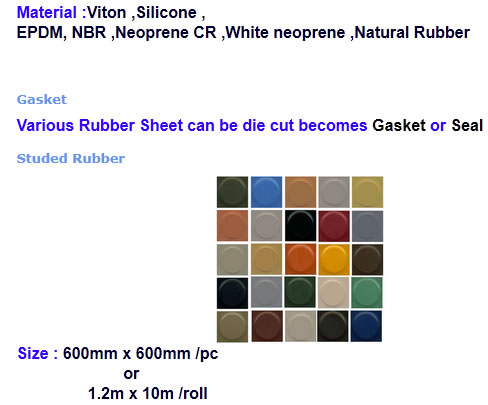
|
Materials sheet |
|
NBR |
|
This synthetic rubber is very good resistant against effect of fuels and oils, in particular hydraulic oils, greases, as well as other aliphatic hydrocarbons, acids and caustic solutions. Good physical values as for example high abrasion resistance and stability and a favorable temperature range from -25 C to +100 C protect a broad range of application to this rubber. |
|
|
|
HNBR |
|
Of NBR polymers by full or section hydrogenation of the double connecting butadiene proportions one makes. Thus the heat and oxidation stability rise with by-oxidic networking. High mechanical firmness and improved resistance to wear distinguish the materials made of it. Medium stability is comparable with NBR. Temperature range -30°C to +150°C |
|
|
|
SBR |
|
Materials
from SBR (polymer from butadiene and styrene) are used preferentially
in hydraulic brakes as sealing element. Good stability in inorganic and
organic acids and base, brake fluids on Glycol base, water and alcohol.
Not suitably in mineral oils, grease, fuels and aliphatic, aromatic and
chlorinated hydrocarbons. |
|
|
|
Silicone |
|
The field of application of this rubber does not result from the temperature range -55°C to +200°C however to hot waters or steam to be transferred may. Although the oil resistantness of the silicone rubber near-goes approximately to from NBR, the good become physical and mechanical characteristics of this material does not achieve. |
|
|
|
Fluorsilicone |
|
Fluorine silicone rubber indicates a still substantially improved stability apart from the typical characteristics of the normal silicone rubber (VMQ) opposite oils, fuels and solvents. This applies particularly to aromatic and chlorinated hydrocarbons and alcohols. Fields of application are with high request over a wide temperature range from -75°C to +200°C during simultaneous effect of aggressive media e.g. gasoline, alcohol mixtures, aromatic oils and a set of chlorinated solvents. Typical applications are seals in the fuel area of the automobile and aircraft construction, as well as in the chemical industry. |
|
|
|
FKM/Viton |
|
Very good resistant against diluted acids, weak alkalis concentrated extraordinary stability against the effect of mineral oils, aliphatic and aromatic hydrocarbons as well as chlorinated hydrocarbons. An excellent temperature range from -20°C to +230°C and high mechanical values place this synthetic rubber the high over conventional synthesis rubbers. The likewise very small gas permeability and outstanding resistance to aging with a very good remaining pressure deformation let fluorine elastomers connected almost appear as ideal material. |
|
|
|
ACM |
|
The outstanding characteristic of acrylate rubber is its excellent heat and hot oil resistantness. ACM is resistant to engine oils with modern additives, transmission oils, greases etc.. In addition come the high oxidation -, aging and ozone stability of a satisfied polymer chain. Temperature range from -30°C to +150°C. |
NR |
|
Natural rubber is a high elastic material with very good physical characteristics, excellent mechanical firmness and very good low temperature resistance. Despite the many other synthetic rubber the available natural rubber finds types with their special features still an important area of application e.g. for suspensions, machine stocks, rubber metal connections. Temperature range -50°C to +90°C. |
|
|
|
EPDM |
|
Seals from EPDM indicate very good ozone -, aging and weather a stability. The further area of application for this rubber is, where high hot water and steam stability of the assigned seal are required. The cold-resistantness is compared, with the usual synthetic rubber types to call good. The behavior against oils, greases and solvents corresponds about from butadiene styrene rubber (SBR). The chemical resistance, also against oxidizing working agents is very good. Strongly pouring in aliphatic, aromatic and chlorinated hydrocarbons. Temperature range from -40°C to +150°C. |
|
|
|
Aflas |
|
Aflas is belonged an by-oxidically interlaced TFE elastomer and to the new generations of fluorine elastomers. Alfas of sealing elements show an unusual good stability in relation to a multiplicity of specific media and chemicals e.g. hot water, water steam, acids, caustic solutions, ammonia, bleach, sour gases (H2S) and oils as well as amines, in particular media with amine additives and corrosion inhibitors, engine and transmission oils, brake fluids and oxidized media alloyed. The application temperatures are similar to those of the fluorine elastomers from -30°C to +200°C constant temperature. |
|
|
|
CR |
|
The chemical and physical characteristics are approximately comparable with NBR. Good resistant against aging, weather, ozone, refrigerant, acids and alkalis temperature range from -40°C to +110°C. |
 Malaysia
Malaysia